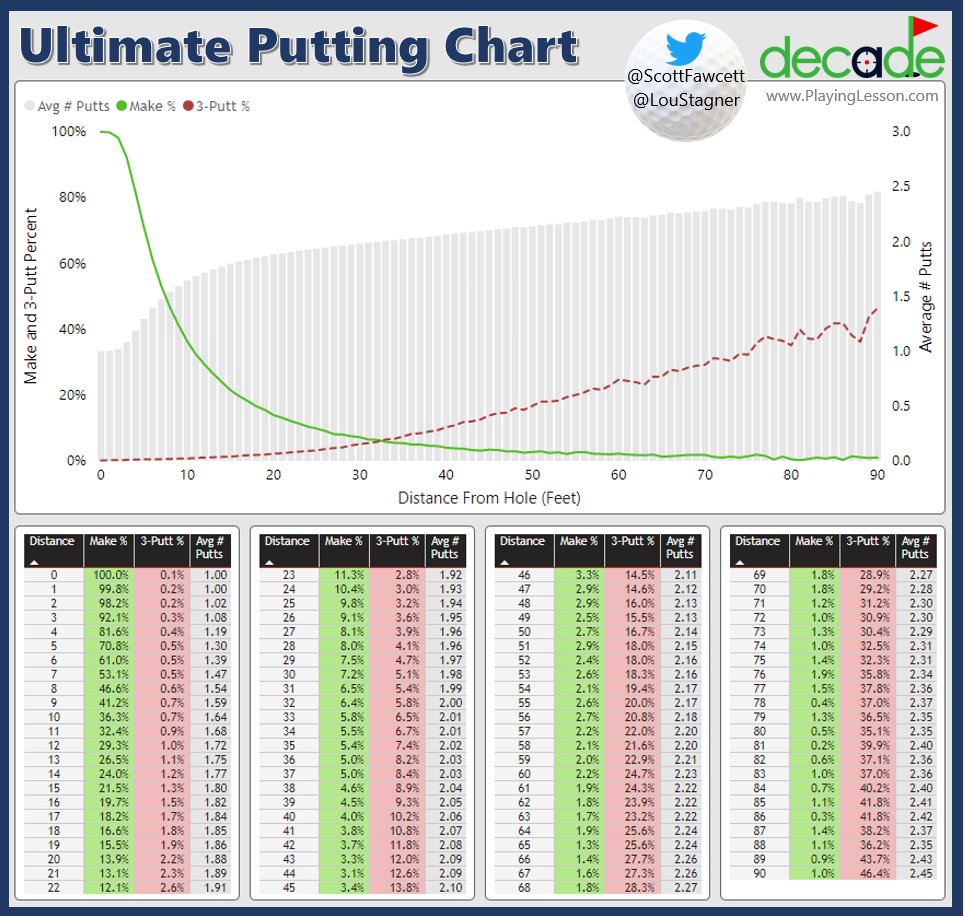
Greens in regulation is one of the foundations of golf statistics. But what are the expected greens in regulation by handicap index?
If you’ve ever picked up a golf club in your life, chances are you’ve heard someone say, “Drive for show. Putt for dough.”
Well…
This is a little misleading.
You do need to putt decently to shoot a good score.
But I wouldn’t say you have to putt well.
Sure, it helps.
But putting is hard.
And, if I’m being honest, the difference between a good putting day and a bad putting day is probably not as many strokes as you think.
Seriously, think about your best and worst putting days.
How many more long putts did you actually make on your best days?
Maybe 2?
And you walked off the course feeling like a rock star, didn’t you?
I know I do.
However, there’s a much better indicator of how well you’re playing.
Since you’ve clicked on this page and have probably read the headline, I’m going to assume you already know it’s greens in regulation.
Of all the traditional golf stats, greens in regulation is the one most correlated statistic to scoring.
Especially for us *******(link to about page)amateur mules.
But how many greens should you be hitting based on your handicap?
And how does that compare to the handicap you want to get to?
Let’s find out.
>> Related: 5 Best Ways to Lower Your Handicap

Greens in Regulation Meaning: What is GIR?
Before we get to the good stuff, let’s cover what greens in regulation actually are.
(If you’re already a seasoned weekend Muni mule, feel free to jump down to the next section.)
Greens in regulation (GIR) is a simple measure that calculates how many strokes it took you to find the green in relation to par.
When course designers set par for a hole, they always determine how many strokes it should take you to find the green and then add 2 more strokes to account for putts.
Based on this logic, we can simply subtract 2 from every hole’s par to find how many strokes are needed for a green in regulation.
- Par 3: 1 shot for a GIR.
- Par 4: 2 or less shots for a GIR.
- Par 5: 3 or less shots for a GIR.
Every time you hit a green in regulation, you are guaranteed at least a birdie putt.
With the added potential on short par 4s or par 5s where you can hit the green under regulation and leave yourself a chance at eagle.
This is all well and good, but what are the expected greens in regulation by handicap?
Greens in Regulation by Handicap
Knowing what a GIR is is only as good as what you can do with it.
Luckily there’s a lot of data that supports the importance of hitting greens in regulation when you are trying to improve your golf game.
As I mentioned before, it’s the one traditionally kept stat that still holds water in the current climate of golf.
Even with the insane distances tour pros hit the ball now.
Let’s take a look at what you can expect for greens in regulation by handicap.

This data is pretty damning on the importance of hitting greens.
However, I hope it also goes to show that you don’t have to be perfect.
Hitting all 18 greens for a tour pro is more rare than getting a hole-in-one.
We will come back to tour pros more in a little while, right now I just want to focus on us amateur mules.
This evidence shows that if you go from a 20 handicap to a scratch golfer, SEVEN of the 20-shot difference is coming from simply hitting the green.
That’s a ton!
I guarantee there is no other single stat with that much variance.
And if we look deeper, the difference is actually more than just those seven shots.
Consider what happens when you don’t hit the green.
Specifically the times when you write an 8 on your scorecard and wonder how the hole got so out of hand.
Was it because you missed the green in regulation, but managed to recover and make it on with just one extra stroke followed by a 5 putt?
I’m willing to guess not.
More often than not our blow-up holes come from trying to get out of a bunker for 3 shots.
Or being stuck in the trees and trying to hit a hero shot that hits a tree.
Or piping a tee shot out of bounds only to think we should still attempt the same impossible shot and pound another ball OB.
All of those result in missing the green in regulation and taking way more than just one shot to recover.
Before you know it, those seven shots of difference boil over into 10-15 shots very quickly.
And your dreams of being a single-digit handicap quickly evaporate.
Why are Greens in Regulation so Important?
I don’t care who you are, you’re a better putter than a chipper.
Period.
For reference here’s the legendary Lou Stagner with how far you need to be for chipping and putting to result in the same number of average strokes to finish the hole. (I realize it says chips from the rough, but you get the idea.)
Chips from rough vs putting for a 10 index:
— Lou Stagner (Golf Stat Pro) (@LouStagner) August 16, 2023
5 yard chip = 58 foot putt
6 yards = 61 feet
7 yards = 65 feet
8 yards = 68 feet
9 yards = 72 feet
10 yards = 77 feet
These numbers are *about* the same for every handicap index.
Understandably, there’s a lot of variability that can make certain situations differ from others.
However, the point here is that if you have a 5-yard (15-foot) chip, you’re expected to make the same score as if you had a putt from FOUR TIMES farther away.
I mentioned variability and while there certainly may be times when chipping is the right play, chips garner many more chances that the deck is stacked against you.
You could have a bad lie, you might have to ship over an obstacle, or maybe it’s just deep grass and there’s nothing else to do but hack and hope.
Compare that to being on the green where every shot you inevitably hit has the exact-ish same lie.
You might be on a slope or you might be on the wrong tier of a green, but every putt is going to have a much more predictable set of circumstances.
It doesn’t even matter how close you are to the hole!
Just get it on the green.

According to PGA Tour data, expected strokes to hole out decreases exponentially as you get farther from the hole.
(I know this is talking about tour pros. But the shape of our amateur curve is very similar.)
Let me explain that with a little less math jargon.
Assuming a one-foot putt is a guaranteed make, the expected shots to hole out decrease by half a stroke by the time you are eight feet away.
But the next half-stroke decrease doesn’t occur until you are 32 feet away.
Again talking about tour pros here.
I think this stat surprises more people than are willing to admit.
I know it surprised me when I first saw it.
While some people might read that and infer that it’s VITAL to be right next to the hole, I would encourage you to see it the opposite way.
You’re not going to hit approach shots within 5 feet.
If you do, it’s an accident. (We can argue over this on a different day.)
So rather than stress about being right next to the holes, just make sure you’re on the green.
Who cares if you are 20 feet away or 30?
You’re only losing a fraction of a shot. A very small fraction of a shot.
And if 30 feet away is going to keep you away from a bunker or a water hazard, the trade-off might even be saving you multiple full strokes.
Sounds well worth it to me.
To summarize, aim at the center of the green.
At. All. Costs.
How to Improve Greens in Regulation No Matter Your Handicap
The first part of this is so obvious, I’m not even going to go into grave detail.
I’m just going to mention it and move on.
Practice.
You have to practice. (Click here to see my favorite practice drills.)
Specifically with approach shots.
For most of us, this is inside the 150-yard range.
And this should probably consume about 75% of the shots you hit on the practice range if you’re serious about dropping your handicap.
Yes, it’s that important!
Now that that’s out of the way, let’s take a look at a few other ways to increase greens in regulation.
1. Stop Aiming at Flags
Ever been short-sided with a downhill chip?
It’s the worst.
Nothing like hitting the best shot possible and it still rolls 18 feet past the hole.
How can you prevent it?
Stop aiming at the flag!
The logic here has to do with shot variance.
I don’t care who you are, golf is one of the hardest sports because of how little control you have.
In no other sport do you have upwards of 6 seconds between when you make contact with the ball and when it finally comes to rest.
Therefore you have to play as safely as possible.
The intent here is to minimize the uncontrollable as much as possible.
Namely wind.
But also bad bounces or uneven lies that can make your next shot even more difficult.
Not only that, but it’s also impossible for us to make the exact same swing on every shot we take.
Even Tiger Woods mishit shots in his hayday.
He just knew how to miss better than everyone else.
We have to account for that when we are aiming.
If you are aiming 20 feet right of a hole and the wind pushes it left, that’s ok.
You have 20 feet of room to play with.
Aim the same 20 feet right and watch the wind push it farther right and it’s still ok.
If you were aimed at the middle of the green, you are likely still on the green, but now have a 30-35 foot putt instead of 20.
The fact you’re still putting means it’s a small fraction of a stroke worse and you can easily get that fraction back on a different hole later in the round.
Aggressive swings to conservative targets.
That’s your secret here.
Let your normal distribution of shots be the decider on when your approach lands 2 feet from the hole and leaves your tap in birdies.
2. Better Tee Shots
When it comes to greens in regulation, most of the attention gets directed at hitting approach shots.
For good reason, I would argue, it is the shot that actually does the hitting of the green.
However, you can’t hit a good approach shot if your ball is behind a tree.
Or in a lake.
For this reason, it never hurts to be better off the tee.
And if I’m being honest this is probably the fastest way to hit more greens because it’s often easier to get better at tee shots than approach shots.
Part of this lies in the reality that you don’t have to be great with a driver.
You just have to be good enough.
Most of the time you are standing on a tee, you’re holding the club with the biggest clubhead and therefore the biggest sweet spot.
Your job is to simply put a good enough swing on it so you can keep it on the planet. (There are also some drills for this in the practice article I mentioned earlier.)
It doesn’t even matter what side of the fairway you are on.
Hell, it doesn’t even matter if you are in the fairway.
Just hit it as far as you can without being in a hazard.
Or behind a tree.
Does Distance Matter?
Yes.
But probably not as much as you think.
However, for most of us amateur golfers, I think you’d be surprised at how little the difference is between a 100-yard approach and a 120-yard approach.
But they are both SIGNIFICANTLY better than the approach from under a tree or in a bunker.
Let me be very clear, I’m not telling you to hit less than driver.
I’m just telling you not to swing 110% on your driver.
Take a controlled swing with intent and be ok with losing a few yards so minimize the chance that you have to play your next shot from a bird’s nest.
4. Play the Right Golf Ball
This tip might surprise you.
Do you actually know if your golf ball is helping your game?
Do you even play the same ball on every shot?
Or do you just play whatever ball falls out of your bag when you roll up for your ‘show-and-go’ tee time?
If you’re not playing the same golf ball on every shot, you’re doing it wrong.
The differences in golf balls can be drastic and the most prominent differences usually come from the distances we all hit our approach shots from.
If you’ve never tested different golf balls before, we can help you with this guide.
We also have a guide with dozens of the most prominent golf balls on the market.
Both can help you with your golf ball selection process.
The most telling characteristic of a golf ball’s fit is going to come by way of spin and trajectory.
Depending on your swing, how you prefer to play, and even the courses you play most often, different balls are going to perform differently for you.
I want to stress that this should not be an intimidating process.
If you are not a brand loyalist, there is going to be a handful of balls that will all perform relatively similar for you.
You just need to find one you are comfortable playing and stick with it.
(If you are a true beginner at this, we also have a beginner guide to help you too.)

FAQs About Greens in Regulation
What are PGA Tour averages for greens-in-regulation?
PGA Tour players, on average hit right around 12 greens in regulation.
Just about 66%.
Honestly not too far off from the 10.4 greens being hit by amateur scratch golfers.
However, let’s not forget the incredibly different circumstances these tour players are golfing under.
Not only is there way more pressure on the line.
But the greens they play on are also far different than the soft, accepting greens most of us play on at our local muni.
How many greens-in-regulation to break 80?
One of the tricks to breaking 80 is giving yourself the most chances. (Click here to see all the tricks to break 80.)
If you’re on a par-72 course, you’re going to need 11 pars and seven bogeys to make the magic happen.
Logic would tell you that means you need 11 greens.
Good thing the golf course is where logic goes to die.
When was the last time any of us used logic to lay up on a par-5 anyway?
If you want a real chance of breaking 80, you should be hitting between eight and nine greens.
Obviously, the more the better.
But If you can get to 8, the theory is that you won’t be too far away on some other approaches and you’ll have a realistic chance at getting a few up and down for par.
That’s the theory anyway.
How many greens-in-regulation to break 90?
The goal here is five greens in regulation.
One-fourth of the greens is typically what you’ll see here and that would put you at 4.5 greens per round.
So for a slightly reaching goal, I’ll put it at five.
90 is essentially bogey golf, so if you can get to 5 greens in regulation you are accounting for the possibility of a blowup hole or two just to pad your chances.
If you want to see more tips on how to break 90, we have an entire guide here too.
How many greens-in-regulation to break 100?
Breaking 100 gets a lot easier if you can get to four greens in regulation, but if you can get to three you have got a good chance.
If you are in the stage of golf where double-digit scores are your main goal, then some double bogeys are lurking in your rounds.
The goal of trying to hit more greens is to give yourself as big a buffer as possible for any of those blow-up holes.
The easiest way to do this when trying to break 100 is to keep the ball in play.
A la no penalty strokes.
Easier said than done, for sure.
But it’ll get you started on your way to amateur golf addiction.
If you want more detail on hitting greens to break 100, see our full write-up on it here.
Does the fringe count as a green in regulation?
No!
Green is green.
Fringe is fringe.
No sandbaggers here.
Just because you’re not on the putting green, doesn’t mean you can’t putt.
You just can’t count it as a GIR.
Greens in Regulation by Handicap: Final Thoughts
As important as I have made hitting the green seem, I want to stress the management of your expectations.
If you are a 20 handicap right now, there’s no need to set a goal of hitting 10 greens in your next round.
Start by trying to hit the mark for a 15 handicap. Then 10. And slowly move your way down the scale until you achieve the master scratch status.
Just to paint a picture for you, Tiger Woods, arguably the greatest iron player of all time, only hit the green 80% of the time from 100 yards away.
He COMPLETELY missed the green 20% of the time.
So there should be no part of us amateurs that ever gets mad at ourselves when we don’t hit an approach inside of 8 feet. Or 10 feet.
Or whatever ridiculous expectation we set for ourselves.
Golf is hard enough on its own, we don’t need to make it harder by beating ourselves up when we don’t do something we want.
Know what the stats say.
Understand where you are in your golf journey.
And practice those approach shots every chance you get.
Do these things and I guarantee you’ll start hitting more greens and continue lowering that handicap.



Leave a Reply